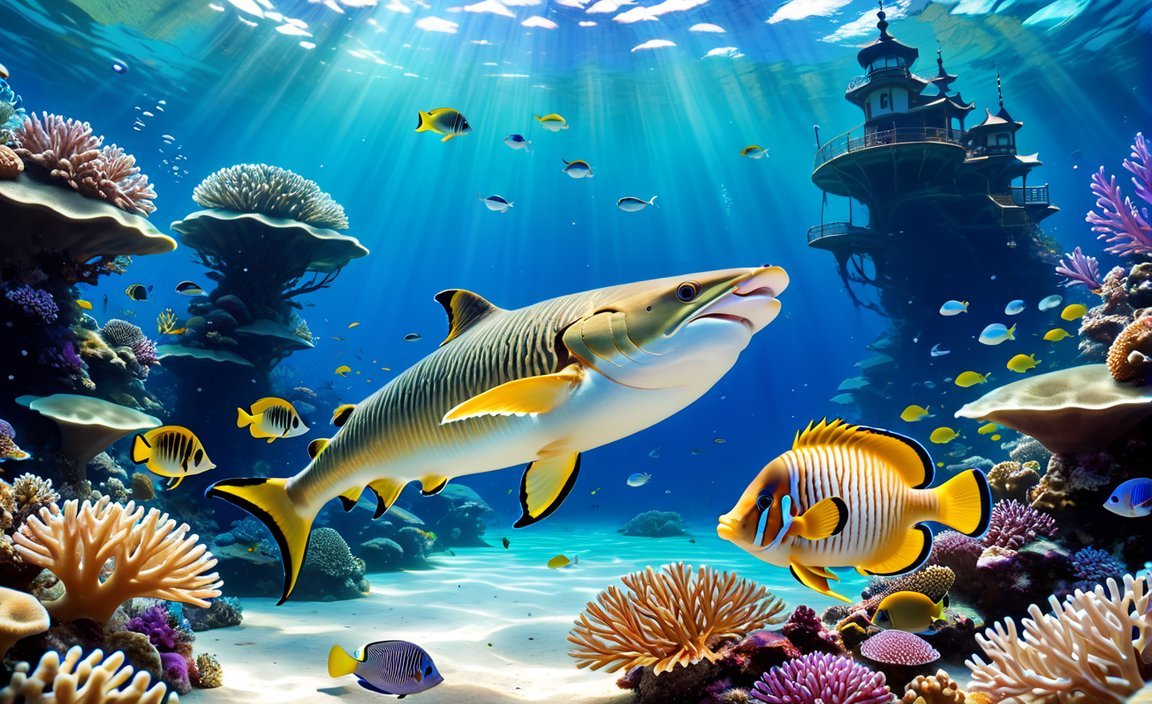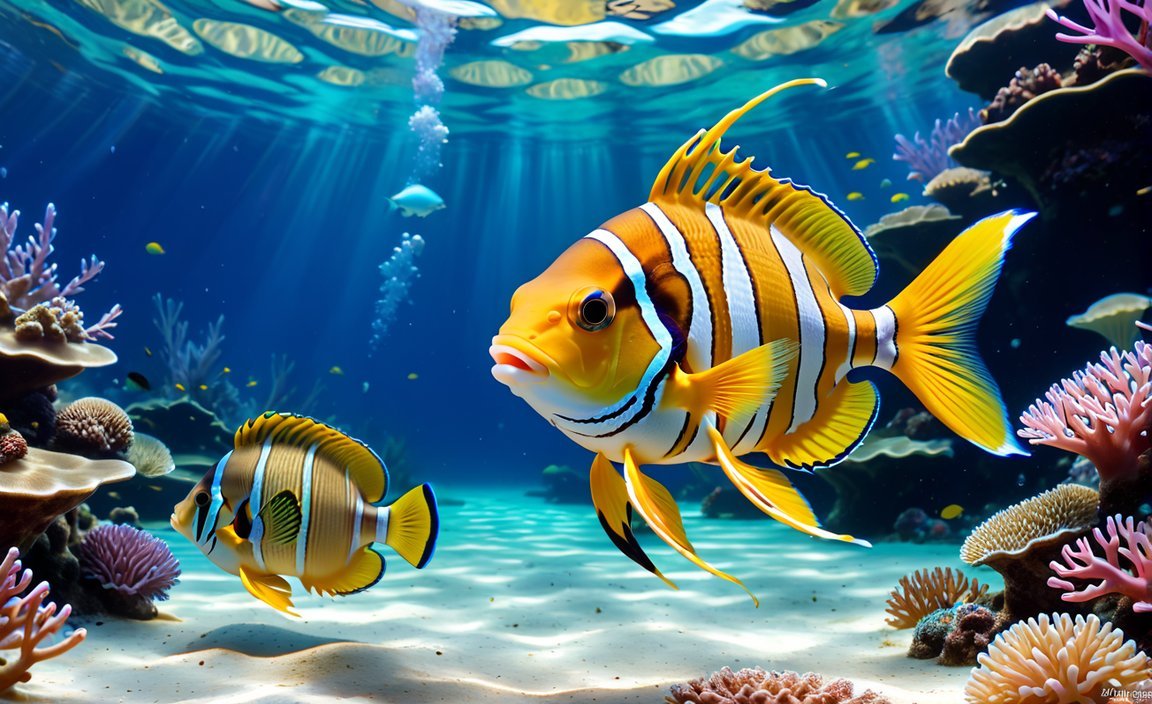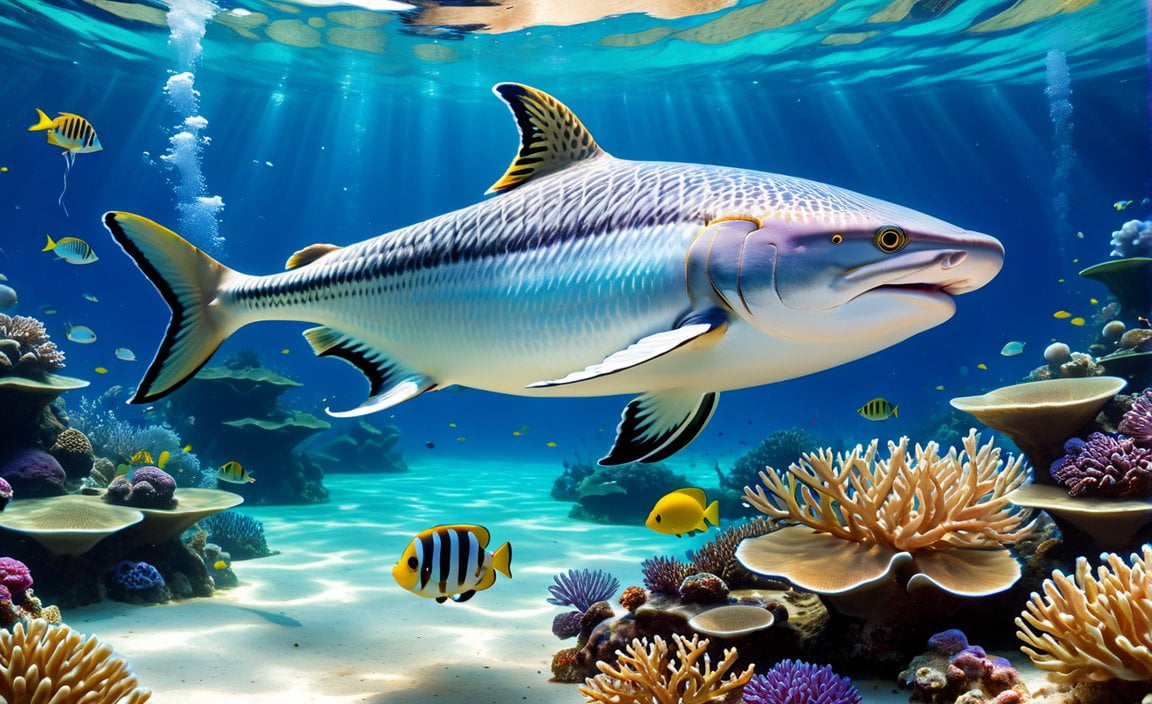Discover 10 Fascinating Aquatic Animal Facts and delve into the awe-inspiring world of marine life. As the Earth’s surface is predominantly covered by the vast ocean, it holds a significant influence on our planet’s climate, acting as its beating heart. Surprisingly, less than 10% of the ocean and less than 50% of U.S. waters have been properly mapped, leaving much untouched territory to explore. Through various disciplines, the USGS plays a vital role in studying the ocean and its inhabitants, unraveling captivating insights into the mesmerizing creatures that inhabit these mysterious depths.
Key Takeaways:
- Jellyfish have been around for over 650 million years, making them older than dinosaurs and sharks.
- Electric Eels possess the ability to generate enough electricity to illuminate up to 10 electric bulbs.
- Dolphins sleep with one eye open and only half of their brain, allowing them to remain vigilant for predators and threats.
- Starfish can possess as many as 16 arms, giving them a unique and distinctive appearance.
- With 95% of their body composition being water, jellyfish are predominantly composed of this essential liquid.
- The largest member of the dolphin family is known as an orca or killer whale, renowned for its size and power.
- Fish have a protective gel-slime covering on their bodies that shields them from parasites.
- Octopuses boast three hearts, which aid in fueling their highly developed circulatory system.
- Sea horses utilize their chins to propel themselves through the water, showcasing their remarkable method of locomotion.
- Sharks possess an impressive immune system that renders them impervious to all known diseases, ensuring their overall excellent health.
10 Amazing Facts About Aquatic Animals

Journey into the depths of the ocean and encounter the wonders of aquatic animals. Prepare to be amazed as we unveil ten fascinating facts about these remarkable creatures. Let’s dive right in!
Fact 1: Jellyfish – Ancient Survivors
Did you know that jellyfish have been gracefully drifting through our oceans for over 650 million years? These ethereal creatures have outlived dinosaurs and even sharks, showcasing their resilience and adaptability. Imagine the stories they could tell if they could speak!
Fact 2: Electric Eels – Nature’s Electricians
Prepare to be shocked by the electric eel, which possesses an astonishing ability. These slimy serpents can produce an electrifying shock that would light up not one, not two, but up to ten electric bulbs. It’s nature’s ultimate light switch!
Fact 3: Dolphins – Unusual Sleepers
Have you ever wondered how dolphins keep an eye out for danger while they sleep? Well, they have a remarkable trick up their fins. Dolphins sleep with only half of their brain and one eye open. This unique adaptation allows them to maintain vigilance against predators and threats. Sleep with caution, dolphins!
Fact 4: Starfish – Arms Galore
Don’t be fooled by their delicate appearance; starfish are true multitaskers. With the ability to regenerate, these enchanting creatures can have up to an astonishing 16 arms. They truly redefine what it means to lend a helping hand, or 16 of them!
Fact 5: Jellyfish – Water Composition
Did you know that a jellyfish is composed of an astounding 95% water? These gelatinous beings exemplify the perfect balance of grace and fluidity. It’s as if they were born to dance in the sea.
Fact 6: Orcas – The Big Leagues
Hold on tight as we discover the largest member of the dolphin family: the orca, also known as the killer whale. These majestic creatures can reach lengths of up to 30 feet and weigh several tons. They command the ocean with their size and power, leaving us in awe.
Fact 7: Fish – Slimy Shield
Fish possess a secret weapon to fend off unwanted parasites. They have a natural gel-slime covering their bodies, providing a protective shield against these pesky invaders. It’s the ultimate self-defense mechanism from the depths of the deep blue.
Fact 8: Octopuses – Lovers with Many Hearts
Let your heart be captured by the incredible octopus, a creature with not just one but three hearts. Their unique anatomical feature showcases their ability to thrive in the depths. It’s a love story that goes beyond the ordinary!
Fact 9: Sea Horses – Chins Up!
Prepare to be enchanted by the whimsical sea horse with its endearing charm. These unique creatures use their chins to pull themselves gracefully through the water. Their seemingly awkward navigation becomes a dance of elegance in the underwater realm.
Fact 10: Sharks – Immunity Masters
Sharks are the epitome of good health, as they possess an astonishing trait: immunity to all known diseases. These powerful predators rule the ocean with their unparalleled strength and resilience. They truly are the champions of survival!
Now that we’ve uncovered ten amazing facts about aquatic animals, you can appreciate the wonders that dwell beneath the sea. Each specialized adaptation and intriguing ability showcases the marvels of nature’s creativity. So, the next time you dive into the ocean or marvel at an aquarium, remember these extraordinary facts and the captivating stories they tell. The underwater world is simply teeming with astonishing surprises!
Here are some fascinating facts about sea animals that will leave you in awe:
– 10 amazing facts about sea animals
India is home to a diverse range of wildlife, including these endangered animals:
– 10 endangered animals in India
Discover the unique and endangered animal species found in Pakistan:
– 10 endangered animals in Pakistan
Explore the rich biodiversity of Arunachal Pradesh with its endangered animal population:
– 10 endangered animals of Arunachal Pradesh
5. Less than 10% of the world’s ocean, and less than 50% of U.S. waters, have been mapped.

Did you know that less than 10% of the world’s ocean has been fully mapped? And it gets even more surprising – less than 50% of U.S. waters have been mapped as well! This means that there are vast areas of the ocean that remain unexplored and uncharted, holding untold mysteries and hidden treasures.
Mapping the ocean is no easy task. The sheer size and depth of the ocean present enormous challenges for scientists and researchers. But why is it important to map the ocean? Well, let’s dive deeper into this fascinating subject and discover why mapping the ocean is essential for our understanding of aquatic life.
1. Revealing Hidden Landscapes: Mapping the ocean allows us to reveal hidden landscapes beneath the water’s surface. Underneath the waves lie underwater mountains, deep canyons, and vast plateaus. By mapping these features, we gain valuable insights into the geology and formation of the ocean floor.
2. Understanding Habitats: Mapping the ocean helps us understand the diverse habitats that exist beneath the surface. From coral reefs teeming with life to the dark depths of the trenches, each habitat provides a unique ecosystem for marine creatures. By mapping these habitats, we can identify critical areas that need protection and conservation efforts.
3. Tracking Migration Patterns: Mapping the ocean enables us to track the migration patterns of aquatic animals. Many species of fish, turtles, and whales undertake long-distance migrations across the ocean. By understanding these migration patterns, we can better protect these animals and their habitats.
4. Identifying Biodiversity Hotspots: Mapping the ocean helps us identify biodiversity hotspots, areas where a high number of species exist. These hotspots are crucial for the health of marine ecosystems and play a significant role in maintaining the balance of life in the oceans. By mapping these hotspots, we can focus our conservation efforts and ensure the protection of these vital areas.
5. Uncovering Hidden Species: By mapping the ocean, we can uncover hidden species that have yet to be discovered and classified. It is estimated that there are millions of species in the ocean that are yet to be identified. Mapping allows us to explore new areas and document the incredible variety of life that exists beneath the waves.
Key Takeaways:
- Less than 10% of the world’s ocean and less than 50% of U.S. waters have been fully mapped.
- Mapping the ocean helps reveal hidden landscapes and understand diverse habitats.
- It allows us to track migration patterns and identify biodiversity hotspots.
- Mapping uncovers new species yet to be discovered and classified.
Sources:
– USGS.gov – Top 10 Things You Didn’t Know About the Ocean
– National Geographic Society – Ocean
10. USGS studies the ocean in many ways and using many disciplines.
The ocean is an incredible and vast ecosystem, covering 71% of the Earth’s surface. It’s home to a wide variety of aquatic animals, each with their own unique characteristics and abilities. As a marine biologist, I am constantly amazed by the wonders that exist beneath the sea. In order to understand and protect this fragile ecosystem, scientific research plays a crucial role. One organization that is at the forefront of studying the ocean is the U.S. Geological Survey (USGS).
The USGS studies the ocean in many ways and using many disciplines, employing a multidisciplinary approach to gain a comprehensive understanding of this complex environment. Through their research, they aim to improve our understanding of various aspects of the oceanic system, from the continental shelf to the deep sea.
Oceanography and limnology are two main fields of study within aquatic science. Oceanographers focus on studying the physical, chemical, and biological characteristics of oceanic environments, as well as the interactions between the ocean and the atmosphere. They explore everything from ocean currents and tides to the behavior and distribution of marine organisms.
Biological oceanography, a critical branch of oceanography, specifically delves into understanding the ocean’s plants and animals and their interactions with the marine environment. This field of study helps us uncover the various adaptations and behaviors of aquatic animals, shedding light on their intricate relationships within the underwater ecosystem.
The USGS utilizes a range of methods and approaches to conduct their research. They employ cutting-edge technology such as satellites, buoys, and underwater vehicles to collect data on ocean dynamics, biodiversity, and the impacts of climate change. By combining data from various sources, they create detailed maps and models that provide valuable insights into the ocean’s ecosystems.
Mapping plays a vital role in understanding the ocean and its inhabitants. Currently, less than 10% of the world’s ocean and less than 50% of U.S. waters have been fully mapped. However, ongoing mapping efforts allow scientists to reveal hidden landscapes and underwater features, providing a deeper understanding of the ocean’s topography.
Mapping also helps identify diverse habitats and biodiversity hotspots, which are critical for marine ecosystems. By tracking migration patterns and uncovering new and unidentified species, scientists are able to paint a clearer picture of the incredible diversity that exists within the ocean.
Through their work, the USGS contributes to our knowledge of the ocean and helps inform conservation efforts. Their studies are essential for understanding the impacts of human activities, climate change, and pollution on marine life. By studying the ocean in many ways and using many disciplines, the USGS provides valuable insights that contribute to the preservation and sustainable management of our oceans for future generations.
Key Takeaways:
- The US Geological Survey (USGS) is a leading organization in studying the ocean.
- They employ a multidisciplinary approach to gain a comprehensive understanding of the oceanic system.
- Oceanography and biological oceanography are key fields within aquatic science.
- The USGS utilizes advanced technology and mapping techniques to collect data on the ocean.
- Mapping efforts help reveal hidden landscapes, track migration patterns, and identify biodiversity hotspots.
- USGS studies contribute to conservation efforts and the understanding of human impacts on the ocean.
Sources:
– USGS.gov: Top 10 Things You Didn’t Know About the Ocean
– USGS.gov: Ocean | U.S. Geological Survey
FAQ
Q1: How much of the Earth’s surface does the ocean cover?
A1: The ocean covers 71% of the Earth’s surface.
Q2: How does the ocean influence and regulate Earth’s climate?
A2: The ocean influences and regulates Earth’s climate, acting like the planet’s ‘heart.’
Q3: What percentage of the world’s ocean and U.S. waters have been mapped?
A3: Less than 10% of the world’s ocean, and less than 50% of U.S. waters, have been mapped.
Q4: What is the main focus of USGS studies on the ocean?
A4: USGS studies the ocean in many ways and using many disciplines.
Q5: What are the two main fields of study in aquatic science?
A5: The two main fields of study in aquatic science are oceanography and limnology.










